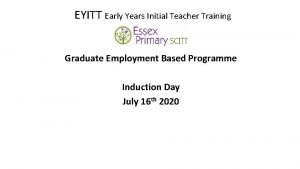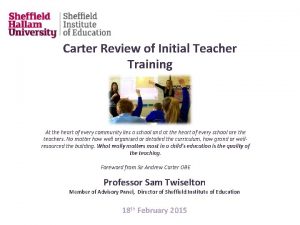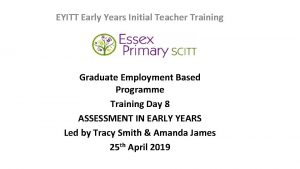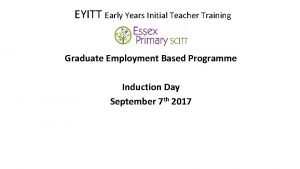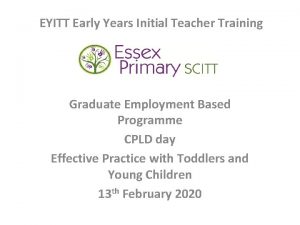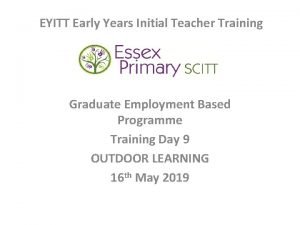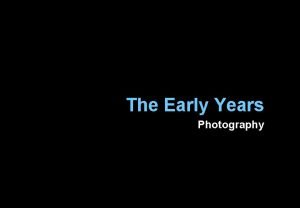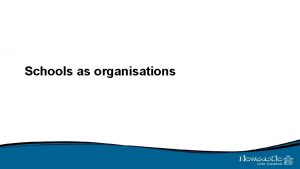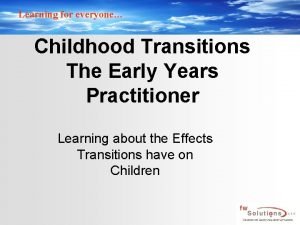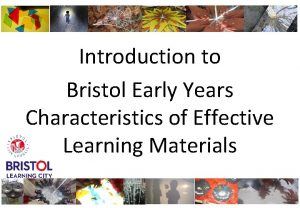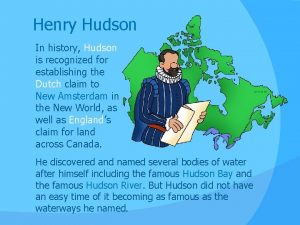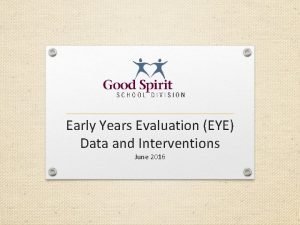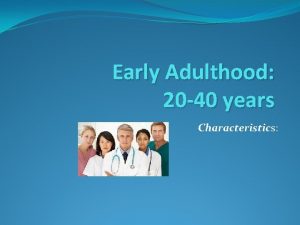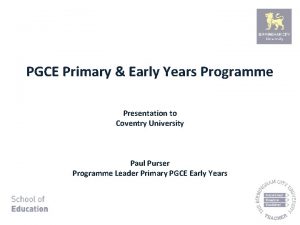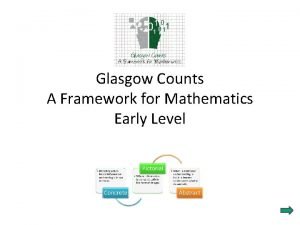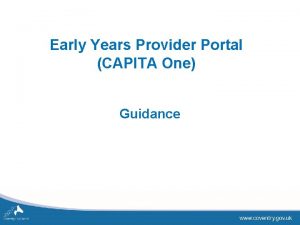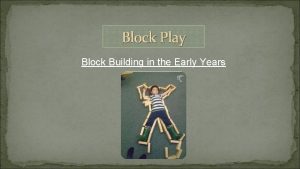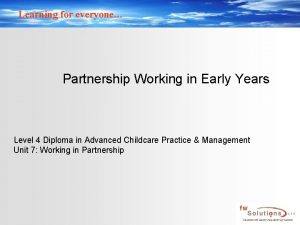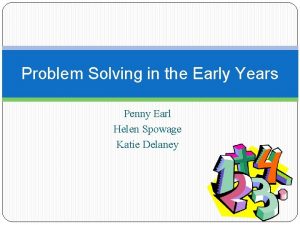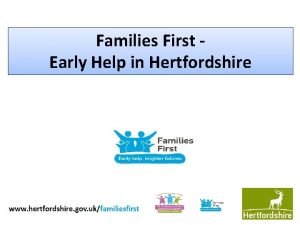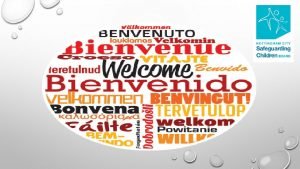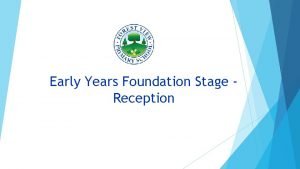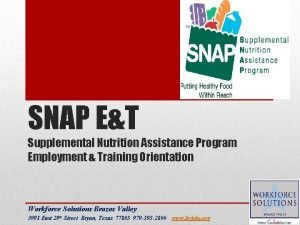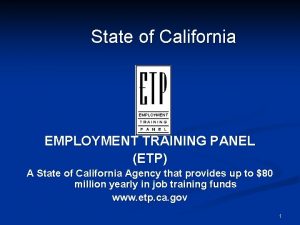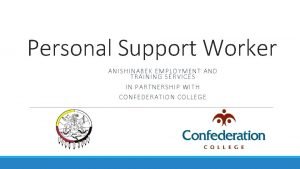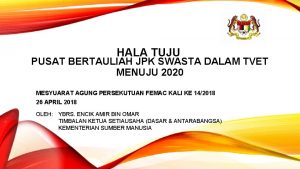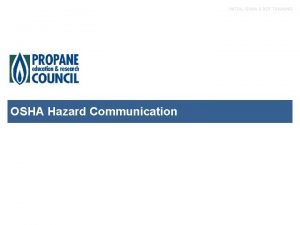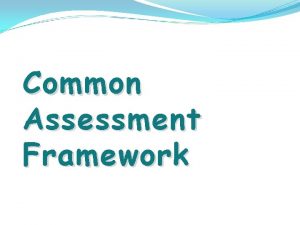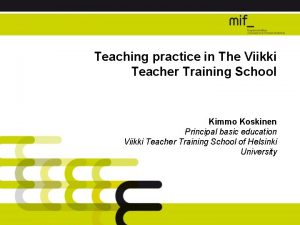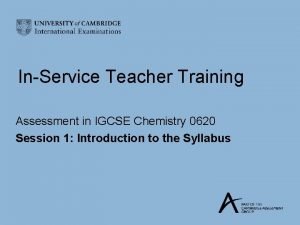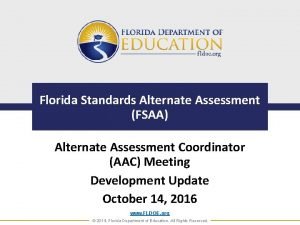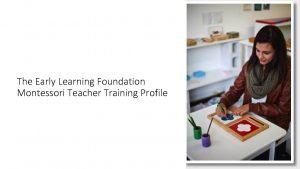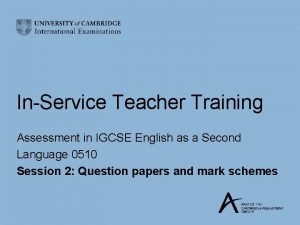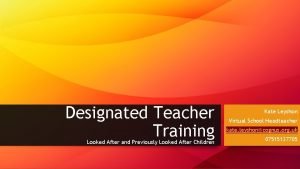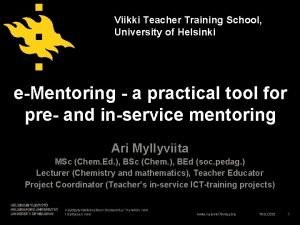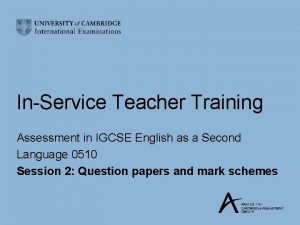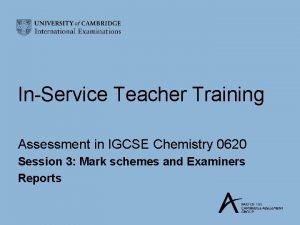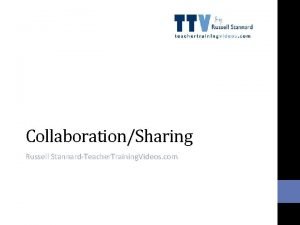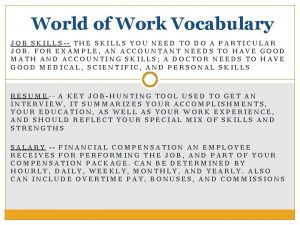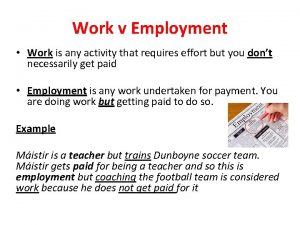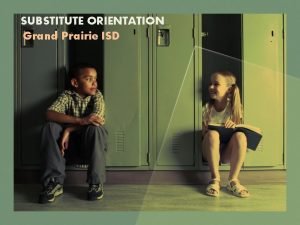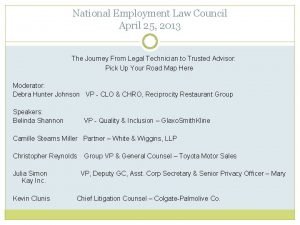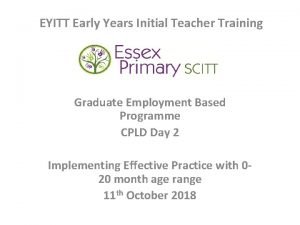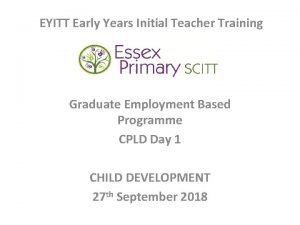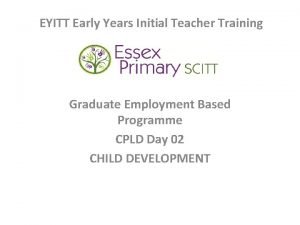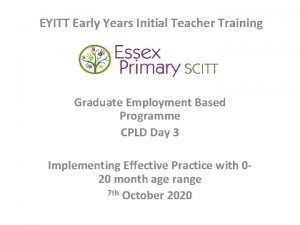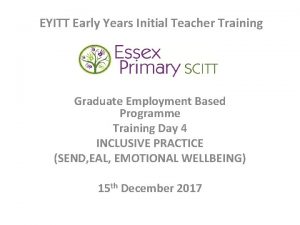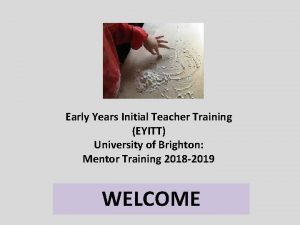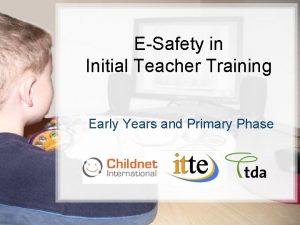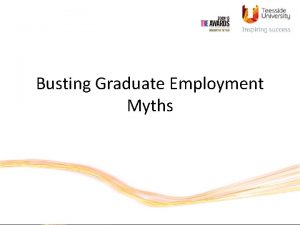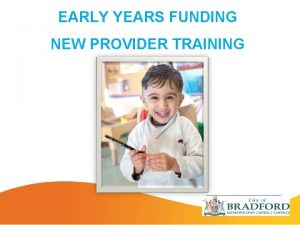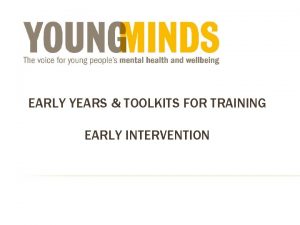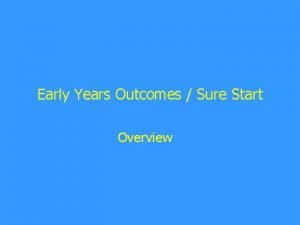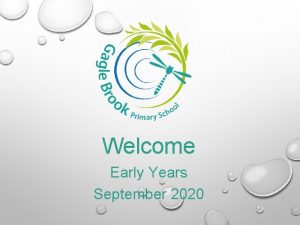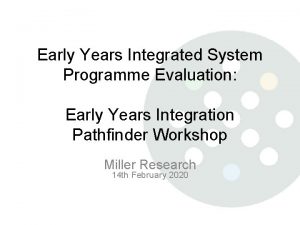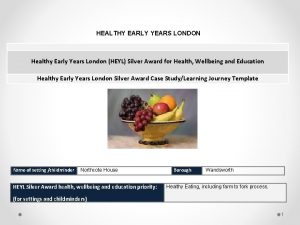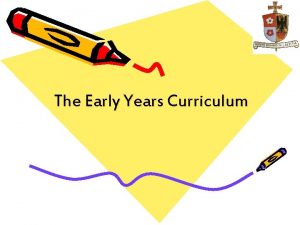EYITT Early Years Initial Teacher Training Graduate Employment



































































- Slides: 67

EYITT Early Years Initial Teacher Training Graduate Employment Based Programme CPLD Day 1 9 th September 2020

Objectives for the day… • • • Introduce the structure of CPLD days Re-cap of the course requirements Have an understanding of assessment requirements and processes Have a deeper understanding of the Teachers’ Standards (Early Years) Begin to critically reflect on current practice and make links to the teacher standards To discuss completed self-audit Discuss individual development plan Engage with the setting plan and understand it’s purpose Explore key theorists • Start getting to know each other and share ideas!

Programme Requirements set by the Df. E R 2. 2 Trainees must teach across the 0 -5 age range and engage with the educational continuum of expectations, curricula and teaching in key stage 1 and 2 (to enable you to do this we hope you will complete a 2 week KS 1 placement in Spring or Summer term) Trainees will be assessed teaching in their place of employment R 4. 1 For the period of their training all trainees must be employed in a setting offering EYFS R 4. 2 Trainees’ working timetable should be no more than 90% of the full time working hours of an Early Years Teacher (other 10% equals half a day a week)

Placements: Different age phase (Optional but highly recommended) • It is highly recommended that, if possible, you gain experience of teaching in a different age phase in your setting • This will give you a more in-depth understanding of both the EYFS Framework and curriculum continuum • You could complete this in any way you wish e. g. one day a week; a two week block; half a term etc.

Placements: Key Stage 1 placement (Optional but highly recommended) 10 day placement at key stage 1 • Should take place in Spring or Summer term • Must be arranged mutually between trainee and school / setting • Placements are required to read the partnership agreement and sign the declaration

Further guidance on placements: • Trainees must not enter any setting until DBS clearance has been received • Trainees are expected to be professional at all times when attending placements • Trainees are expected to adhere to the setting’s local policies and procedures Questions on placements

Partnership agreement Sets out the responsibilities of each partner • Employing setting • Trainee • KS 1 placement (if attending) • Essex Primary SCITT It should be signed by each partner and a copy retained by the trainee in their portfolio, each setting or school and a copy returned to Essex Primary SCITT

Finance • Employing settings receive a financial incentive from the Government of £ 7000 to support trainees to complete the programme • This funding will be paid in 10 equal monthly instalments of £ 700 from October to July through our Attain Academy Partnership • This funding should be used towards the costs incurred by the employer in supporting and employing the trainee over the period of their training • Settings will need to complete a financial audit of how the funding has been spent

How could employers use the incentive… • Salary enhancements • Travel costs for attending training days • Specific resources to support trainees’ on the programme e. g. additional text books • Ensuring the trainee receives 10% non contact time every week • To cover staffing costs to release the setting mentor in order to support the trainee

External mentors Will • Provide advice, guidance and support • Encourage you to think critically and reflect on your practice • Monitor your progress in meeting the standards • Contact you monthly via email / phone as required • Complete 7 formative assessment visits • Support you to develop action plans • Provide ongoing feedback and targets for further development • Flag any cause for concern

Setting mentors Setting mentor support resources – explain the requirements and outline how setting mentors will support trainees through… • Regular meetings to review progress and agree actions to support development • Regular observations of trainee in practice • Joint observations with external mentors and input into progress reviews

Assessment overview Assessment observation visits • External mentors will complete 7 visits, some will be joint with setting mentor • Tracking progress against Teachers’ Standards (Early years) supported by setting mentor • Opportunity to review portfolio and setting plan Written assignments/tasks Professional Portfolio • Change Project –an action • Trainees are required to provide 2 research project undertaken in – 4 pieces of evidence per sub your employment setting standard • Choice of a written assignment • Each piece of evidence should be exploring approaches and clearly annotated and linked to pedagogy in the early years the standards • SST task • Attachment task • Maths tasks • Phonics audit • KS 1 tasks ( optional but highly recommended) • CPLD day interim tasks • Other tasks as required

Assessment criteria Criteria trainees are required to meet…. . . • All 8 Teachers‘ Standards (early years) must have been met in practice • Trainees will have specifically evidenced the 0 -5 age range and the KS 1/2 continuum (where they are able to) • Trainees will have specifically evidenced leadership of practice as in standards 6 and 8 • Trainees must provide evidence of their knowledge , undertanding and hands on practice with young children form birth to five years (where they are able to)

Top Tips…. . Lessons learnt from previous trainees…. • Gather and annotate protfolio evidence as you go (don’t leave it until the end) • Make the most of the reading material and relevant research we provide you with • Be wary of 'what’s app’ groups • Make full use of external mentors and fellow trainees • Be accountable and take responsibility for your own learning

Structure of CPLD days • • • Review/theory Practice 1 Practice 2 Planning theme Interim task

Theory – The Teachers’ Standards (Early Years)

The role of an early years teacher standards preamble • Early years teachers make the education and care for babies and children their first concern • They are accountable for achieving the highest possible standards in their professional practice and conduct • Are graduates who are leading education and care • Have met all the standards in practice from birth to five

• Act with integrity and honesty • Keep knowledge skills up to date and are self critical • Forge positive professional relationships with parents/ carer’s in the best interests of the children

Introduction to the standards 1. Set high expectations which inspire, motivate and challenge all children 2. Promote good progress and outcomes by children 3. Demonstrate good knowledge of early learning and EYFS 4. Plan education and care taking account of the needs of all children 5. Adapt education and care to respond to the strengths and needs of all children 6. Make accurate and productive use of assessment 7. Safeguard and promote welfare of children, and provide a safe learning environment 8. Fulfil wider professional responsibilities

Standard 1 • 1. 1 Establish and sustain a safe and stimulating environment where children feel confident and are able to learn. • 1. 2 Set goals that stretch and challenge children of all backgrounds, abilities and dispositions. • 1. 3 Demonstrate and model the positive values, attitudes and behaviours expected of children.

Standard 2 • 2. 1 Be accountable for children’s progress, attainment and outcomes. • 2. 2 Demonstrate knowledge and understanding of how babies and children learn and develop. • 2. 3 Know and understand attachment theories, their significance and how effectively to promote secure attachments. • 2. 4 Lead and model effective strategies to develop and extend children’s learning and thinking, including sustained and shared thinking. • 2. 5 Communicate effectively with children from birth to age five, listening and responding sensitively. • 2. 6 Develop children’s confidence, social and communication skills through group learning. • 2. 7 Understand the important influence of parents and/or carers, working in partnership with them to support the child’s wellbeing, learning and development

Standard 3 • 3. 1 Have a secure knowledge of early childhood development and how that leads to successful learning and development at school. • 3. 2 Demonstrate a clear understanding of how to widen children’s experience and raise their expectations. • 3. 3 Demonstrate a critical understanding of the EYFS areas of learning and development and engage with the educational continuum of expectations, curricula and teaching of key stage 1 and 2. • 3. 4 Demonstrate a clear understanding of systematic synthetic phonics in the teaching of early reading. • 3. 5 Demonstrate a clear understanding of appropriate strategies in the teaching of early mathematics.

Standard 4 • 4. 1 Observe and assess children’s development and learning, using this to plan next steps. • 4. 2 Plan balanced and flexible activities and educational programmes that take into account the stage of development, circumstances and interests of children. • 4. 3 Promote a love of learning and stimulate children’s intellectual curiosity in partnership with parents and/or carers. • 4. 4 Use a variety of teaching approaches to lead group activities appropriate to the age range and ability of children. • 4. 5 Reflect on the effectiveness of teaching activities and educational programmes to support the continuous improvement of provision.

Standard 5 • 5. 1 Have a secure understanding of how a range of factors can inhibit children’s learning and development and how best to address these. • 5. 2 Demonstrate an awareness of the physical, emotional, social, intellectual development and communication needs of babies and children, and know how to adapt education and care to support children at different stages of development. • 5. 3 Demonstrate a clear understanding of the needs of all children, including those with special educational needs and disabilities, and be able to use and evaluate distinctive approaches to engage and support them. • 5. 4 Support children through a range of transitions. • 5. 5 Know when a child is in need of additional support and how this can be accessed, working in partnership with parents and/or carers and other professionals.

Standard 6 • 6. 1 Understand lead assessment within the framework of the EYFS framework, including statutory assessment requirements (see annex 1). • 6. 2 Engage effectively with parents and/or carers and other professionals in the on- going assessment and provision for each child. • 6. 3 Give regular feedback to children and parents and/or carers to help children progress towards their goals.

Standard 7 • 7. 1 Know and act upon the legal requirements and guidance on health and safety, safeguarding and promoting the welfare of the child. • 7. 2 Establish and sustain a safe environment and employ practices that promote children’s health and safety. • 7. 3 Know and understand child protection policies and procedures, recognise when a child is in danger or at risk of abuse, and know how to act to protect them.

Standard 8 • 8. 1 Promote equality of opportunity and anti-discriminatory practice. • 8. 2 Make a positive contribution to the wider life and ethos of the setting. • 8. 3 Take a lead in establishing a culture of cooperative working between colleagues, parents and/or carers and other professionals. • 8. 4 Model and implement effective education and care, and support and lead other practitioners including Early Years Educators. • 8. 5 Take responsibility for leading practice through appropriate professional development for self and colleagues. • 8. 6 Reflect on and evaluate the effectiveness of provision, and shape and support good practice. • 8. 7 Understand the importance of and contribute to multi-agency team working.

Practice 1 – standards in action

Self-audit

Self-audit In your break out rooms, spend 20 minutes discussing the following: • Areas for development identified through your self-audit • Areas of strength that you believe you have • List 3 actions that you could undertake for 3 areas of development • Do the same for areas of strength

Self audit informs…. . • • The IDP The Setting Plan The Change Project Your evidence base

Using the standards grid progress tracker As a. . . • Tool for tracking how you are providing evidence to each of the standards • Tool for identifying areas for further developing your practice • Actions identified – ways and ideas to ensure you effectively develop your practice • Basis for discussion with your course mentors


Activity • 2 standards per group – explore amplifications and discuss specific sections that you think may be difficult to evidence • Identify as many ways as possible in which you may be able to evidence the sub standards…. . . Observation, peer observations, setting mentor meetings, reflective log, portfolio, written tasks, change project, daily practice!!!

Observing standards in action • Watch the clip provided: https: //youtu. be/efeiz. Nuu. Eo 0 • Using your ‘Standards in action’ document, note examples of the relevant sub-standards that you identified • In your break out rooms, spent 10 minutes discussing and comparing your observations

Lunch

Practice 2 – the IDP and the Setting Plan

Introduction to IDP • • Rationale Sub standards Areas for development Leadership opportunities Actions Success criteria Milestones

Leadership in the early years Leadership – a key aspect of being an early years teacher “leaders of effective settings were both reflective in their own practice and encouraged reflection in their staff” (Blatchford , 2000) “ A leader shapes and shares a vision which gives point to the work of others” (Handy 1992) Research studies emphasise the importance of effective leadership in early years • • EPPE (Effective Provision of Pre-school Education) ELEYS (Effective Leadership in the Early Years Sector) EPPSE (Effective Pre-school, Primary and Secondary Education) REPEY (Researching Effective Pedagogy in the Early Years) Leadership is about inspiring others to promote a shared vision Standard 8 – must provide evidence of leadership

Individual Development Planning • Working in groups begin to address how to complete the individual development plan • The IDP will be completed by the end of visit 1 with your external mentor

Individual Development Planning • In your break out rooms, spend 15 minutes looking through the IDP • Questions?

The Setting Plan Rationale: • Helps to facilitate small changes that can have a big impact • Demonstrates the development of a trainee’s knowledge and practice over time • Demonstrates an in-depth understanding of the standards in action • Engages trainee’s in leadership practices • Develops trainee’s understanding of the crucial role the learning environment plays

Setting plan examples

Planning theme – the Setting Plan • In your break out room, each sketch an ariel view of the layout of the indoor/outdoor classroom. • Highlight the areas that work well and the areas that you feel need developing • Share this with your colleagues and discuss possible actions • Spend 30 minutes on this

Theory 2 – child development theorists

Child Development Theories *www. verywellmind. com

Theorists • Sigmund Freud – Psychosexual Theory – “child development occurs in a series of stages focused on different pleasure areas of the body. During each stage, the child encounters conflicts that play a significant role in the course of development. ”* • *www. verywellmind. com

Freud’s Psychosexual Theory *www. verywellmind. com

Theorists • Erikson – Psychosocial Development Theory – “eight-stage theory of psychosocial development describes growth and change throughout life, focusing on social interaction and conflicts that arise during different stages of development. ”* *www. verywellmind. com

Erikson’s Psychosocial Theory *www. verywellmind. com

Theorists • Burrhus Frederic Skinner – behaviourism – “all human behaviour can be described in terms of environmental influences. Learning occurs purely through processes of association and reinforcement. ”* *www. verywellmind. com

Skinner’s behaviourism theory

Theorists • Jean Piaget – stage theory – “children think differently to adults. Children take an active role in the learning process, acting much like little scientists. ”* *www. verywellmind. com

Piaget’s stage theory

Theorists • John Bowlby – attachment theory – “early relationships with caregivers play a major role in child development and continue to influence social relationships throughout life. ”* *www. verywellmind. com

John Bowlby’s attachment theory *www. verywellmind. com

Theorists • Albert Bandura – social learning theory – “behaviours can be learned through observation and modelling. ”* *www. verywellmind. com

Bandura’s social learning theory *www. verywellmind. com

Theorists • Lev Vygotsky – sociocultural theory – “through interacting with others, learning becomes integrated into an individual’s understanding of the world. • Introduced concept of the zone of proximinal development, which is the gap between what a person can do with help and what they can do on their own. ”* *www. verywellmind. com

Schemas • Schemas are patterns of repeated behaviours that may be observed in young children’s play as they explore and make sense of the world around them. Using their senses and movements, children may show their fascination for moving things here and there, hiding things in small enclosed places, covering themselves and objects, throwing things and watching them fall, and so on. • Schemas are an intrinsic part of child development. They are important to our understanding of how some children learn. Knowing about schemas offers a positive view of children’s actions and enables parents and practitioners to make sense of what children are doing. • Schemas operate at different levels in child development. For children under three years of age, learning develops through ‘sensorimotor’ experiences (absorbing information through what they see, taste, touch, hear and smell and through their own movements) and ‘symbolic representation’ (when they make something stand for something else). Early schemas provide the basis for later learning and development of ‘abstract thought’. *Oxfordshire County Council

Schemas and the under 3 s Schema What it means Examples of what a child may do What adults could do to extend Provide wheelbarrows to move sand; give items that can be moved and provide bags, baskets, containers, trolleys and pushchairs; take on picnics, go on trips or watch trains and buses transporting people, play travelling games with lined up chairs or boxes for going on a bus/train; sing ‘Down at the station’ or ‘The wheels on the bus’; read ‘Whatever next’, etc. Transporting Moving resources and self from place to place Carries items to a special person; moves objects in wheeled toys; puts things in bags and moves them from place to place; carries sand in bucket and takes playdough to the home corner; pushes friends around in a toy pushchair Enveloping Covering themselves or other items Hides under blankets, bath robes, scarves, material, in boxes or dens; loves wearing hats; may cover their face with flannel when washing; wraps things up, paints over pictures; sits in a sand tray and covers their legs with sand; folds a picture and then wraps in more layers of paper Trajectory (straight lines) Learning about movement of things and self in vertical, horizontal and diagonal lines, still and in motion Drops things form high chair or cot; throws things; may gaze at your face; lines things up; climbs up and over; jumps off furniture; runs up and down; draws or paints lines; follows lines painted on the floor/ground; plays with running water in the bathroom; likes to go through tunnels; makes trails with glue; pushes cars or pushchairs in a straight line; knocks over structures built by other children; likes to wear clothes with stripes

Schemas and the under 3 s Rotating (circles) Connecting Enclosing Containing Exploring things that turn, including self Interested in wheels and cogs; likes twirling and twisting themselves, enjoys spinning round or being swung around; runs in circles; rolls down a hill, turns taps on and off, draws circles, likes to watch fans, washing machines and whisks in movement, reaches for round objects near them; likes to watch rolling balls Joining and separating Gives and collects objects from adult; enjoys construction toys which involve joining things together; takes things apart, joins the table and chair by sticking tape across; ties a string to crates or bikes Surrounding self, objects or space with a border Plays with farm animals and makes fences for them; builds enclosures with bricks and puts objects inside; puts cars in a garage, may draw a line around their picture; likes to sit inside a space such as basket or tyre; may surround themselves with cushions Putting self or things inside other objects Posts things behind radiators or in bins; likes to put objects inside boxes, bags and pots, likes to climb into boxes and hide in the cupboards; plays in tents; loves to fill up buckets with sand; may put their thumb in and out of their mouth

Schemas and the under 3 s Positioning Placing objects or themselves in particular places Lies on the floor or under a table; may put things on their head; walks around the edge of a sandpit; prefers to have food items separated on a plate; enjoys lining up cars and threading beads/buttons; likes to stand at the front or back of a line Dabbing Random or specific marks Interested in making marks such as spots or eyes Transforming Exploring changes Likes to see, manipulate and explore changes with dry/wet materials; may add juice to their mashed potato; likes to mix sand water

Knowledge of schemas and understanding schematic behaviour in young children can help practitioners to: Understand why children are doing certain things Describe children’s actions and behaviours in new ways Support parents’ understanding of their children’s learning Inform planning for children’s individual interests, preoccupations and abilities • Be more effective in supporting children’s learning through thought extension and modelling of language, and the provision of enjoyable experiences • Provide real and first-hand experiences for exploration and experimentation • Enable repetition of opportunities • •

Interim Tasks • Research child development theories to present one at next CPLD day. Write reflective log on this. • Conduct a learning walk and complete SSTEW item 10 Be prepared to engage in critical discussion next session!

Website www. essexprimaryscitt. co. uk • • Click on login Select not registered and follow instructions You will be able to login once your registration has been approved Use the forum to access powerpoints, discussions and a range of resources: login; go to EYITT; click on ‘forums’ tab; click on EYFS; access forum

To finish…. . . Questions …. . . Concerns. . .
 Eyitt course
Eyitt course Carter review of initial teacher training
Carter review of initial teacher training Eyfs principles
Eyfs principles Eyitt
Eyitt Eyitt jobs
Eyitt jobs Eyitt
Eyitt Banegas initial english language teacher education download
Banegas initial english language teacher education download Goat years to human years
Goat years to human years 300 solar years to lunar years
300 solar years to lunar years How long is “four score and seven years”?
How long is “four score and seven years”? Shakespeare early years
Shakespeare early years Early years photography
Early years photography Summarise types of early years provision
Summarise types of early years provision Big builders medway
Big builders medway Effects of transitions in early years
Effects of transitions in early years Bristol early years
Bristol early years History of henry hudson
History of henry hudson Eyfs moodle hampshire
Eyfs moodle hampshire Eylf meaning
Eylf meaning Eye early years evaluation
Eye early years evaluation Characteristics of early adulthood stage
Characteristics of early adulthood stage Pgce early years
Pgce early years Glasgow counts trackers
Glasgow counts trackers Coventry early years portal
Coventry early years portal Block play early years
Block play early years Picasso early work
Picasso early work Mark making early years
Mark making early years Early learning for everyone
Early learning for everyone Penny earl and mark
Penny earl and mark Early help module hertfordshire
Early help module hertfordshire Early years summit
Early years summit Nottingham city lado
Nottingham city lado Early years foundation stage pack
Early years foundation stage pack What does abawd mean
What does abawd mean Employment training panel sacramento
Employment training panel sacramento Anishinabek employment and training services
Anishinabek employment and training services Gila river employment and training
Gila river employment and training Graduate enhancement training sarawak
Graduate enhancement training sarawak Osha hazard communication initial training
Osha hazard communication initial training Early cpr and early defibrillation can: *
Early cpr and early defibrillation can: * Erf requirements for teacher 3 2021
Erf requirements for teacher 3 2021 Good morning message to my lecturer
Good morning message to my lecturer Professional development program, rockefeller college
Professional development program, rockefeller college Caf assessment framework
Caf assessment framework Viikki teacher training school
Viikki teacher training school Nature of formative evaluation
Nature of formative evaluation Florida alternate assessment
Florida alternate assessment Elf montessori
Elf montessori Igcse teacher training
Igcse teacher training Designated teacher training
Designated teacher training Vbs teacher training
Vbs teacher training Viikki teacher training school
Viikki teacher training school Igcse teacher training
Igcse teacher training Cie past papers chemistry
Cie past papers chemistry Russell stannard teacher training videos
Russell stannard teacher training videos Training is expensive without training it is more expensive
Training is expensive without training it is more expensive Perbedaan on the job training dan off the job training
Perbedaan on the job training dan off the job training Aggression replacement training facilitator training
Aggression replacement training facilitator training Job search vocabulary
Job search vocabulary What is employment activity
What is employment activity Creighton global engagement office
Creighton global engagement office Employment readiness scale assessment
Employment readiness scale assessment Expected vs actual inflation phillips curve
Expected vs actual inflation phillips curve Grand prairie isd calendar
Grand prairie isd calendar Nes serbia
Nes serbia Fmcsa psp report
Fmcsa psp report Omma caregiver rules
Omma caregiver rules National employment law council
National employment law council
